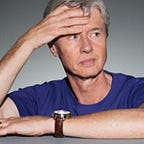Why are we so drawn to photographs of dogs?
“The history of the dog in art is inextricably bound to the history of the dog itself” [The Dog — 5000 years of the Dog in Art by Tamsin Pickeral], and just as in Painting, where dogs have increasingly been used to symbolise something other than Human, an alter-ego if you will, so also in Photography. Some examples illustrate the point:
Stephen Shore — Dust drifts across the road as your feet crunch the gravel. The sound seems so loud as you walk into this empty hot town one early morning. Shadows are thrown across the road as if to deter you. A black dog eyes you, its head lowering. To the left, a wire fence. To the right a man steps out of the shadows. Caught between, you become unsure…it’s as if you have stepped into a scene from “High Plains Drifter”.
Elliott Erwitt — Here Humans become incidental, almost subservient in a role-reversal.
Tony Ray-Jones — Tony Ray-Jones was fond of including dogs to add interest to a photograph. This photograph taken at Crufts, (predating Erwitt), suggests Man in complete servitude to Dog.
Cartier-Bresson — In this Cartier-Bresson image, we see the gestalt factor of similarity being played out as in two pairs, each having meaningful conversations!
And perhaps the two most infamous “black dog” photographs by Koudelka and Moriyama respectively:
Finally, two series of dog photographs that give delight: Martin Usborne’s The Silence of Dogs in Cars
and John Divola’s Dogs Chasing My Car in the Desert (1996–98)
“The dog will never catch a car, and a camera will never capture reality,” said Divola.
Dogs don’t hide who they are. We pretend we can control them but thousands of “dog bites” each year are testimony to the underlying “wildness” of dogs. In photography, dogs have been used in a variety of motifs but underlying them all is the tension inherent in the notion of a “domestic dog”, a contradiction in terms. At some level, it reminds us of parts of our wild selves that are tamed for display. “For, to be sure, how is a man to get relief from the endless dissimulation, falsity and malice of mankind,” wrote Schopenhauer in his essay “On Human Nature,” “if there were no dogs into whose honest faces he can look without distrust?”
